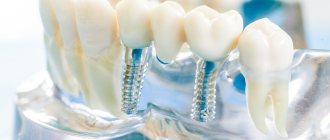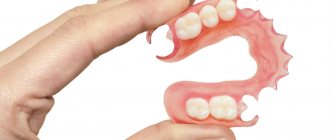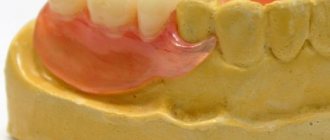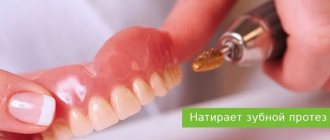Plate prosthesis - what is it and what does it look like?
This is a removable prosthetic structure consisting of a base (made of polymer compounds) and artificial crowns. Some models are equipped with locking elements. As a rule, such prostheses are made of acrylic, polyurethane composition or a nylon base. The final price of the structure depends on the choice of prosthesis material.
Plate dentures are installed in the following cases:
- when a person is missing several teeth or is completely edentulous;
- if it is not possible to perform classical implantation with subsequent prosthetics (for example, with certain contraindications or with limited funds);
- when the patient is allergic to metal alloys;
- when it is impossible to install classic “bridges” or clasp dentures;
- if you need to wear a temporary prosthesis while a permanent one is being made, or dental implants are taking root.
It is important!
A good removable denture structure made from high-quality materials is manufactured strictly in accordance with the individual parameters of the patient’s upper and lower jaw. Standard (ready-made) dentures will never work!
The presented removable dentures are not recommended for installation if the patient has gum disease in the acute stage, suffers from diseases of the circulatory system, or has mental disorders. Also, these prostheses are not recommended for use during chemotherapy in patients with cancer. Prosthetics should be postponed to the future if, at the time of installation of new teeth, a person is diagnosed with inflammatory processes in the body.
The average duration of use of a removable prosthetic structure is from three to five years, but with careful use and provided that a modern prosthesis is installed on implants, it can last ten years.
Experts recommend changing the prosthesis on time, since over time, due to pressure, deformation of the gums occurs, the prosthesis “sags,” the clasps become loose, the material wears out and cannot cope with the distribution of the chewing load, and most importantly, the design no longer copes with its tasks, bone atrophy occurs fabrics.
What is a removable plate prosthesis?
A plate prosthesis consists of two parts - an acrylic base (base) and plastic or ceramic crowns. If the patient is missing only a few teeth, this design is additionally equipped with clasps - metal or acrylic hooks for better fastening of the prosthesis to the supporting teeth.
Previously, the base of the orthopedic structure was made exclusively of hard plastic. However, more modern materials are now used, mainly Acre-Free and nylon
. Such laminar dentures are soft and hypoallergenic, which means that getting used to them is much faster and easier.
The nuances of using plate dentures
- Relative fragility. There is a high risk of deformation under significant loads on the artificial system. If the plastic structure is used carefully and not loaded with solid food, it will last for the entire period of use.
- There are problems with getting used to it and discomfort when wearing it. This is due to pressure on the gums, as well as the large size of the base. At first, there may be problems with diction (especially with pronouncing hissing and whistling sounds). However, modern dental technologies do not stand still - the most comfortable systems are manufactured, which you get used to very quickly, and which do not injure your gums.
- There is no load on the bone. However, if you install a removable prosthetic structure supported by metal implants, the load will be distributed on the bone tissue.
Caring for plate dentures
Easy care of plate dentures is one of their advantages. To extend the service life, you should follow some rules.
· At first, the doctor does not advise removing the dentures, even at night, so that adaptation goes faster, but then, as soon as the discomfort passes, they should be stored in a special container, but not in water, since it serves as a breeding ground for microorganisms.
· To avoid breakage, avoid foods that are too hard or sticky.
· In the morning, evening, and after meals, dentures must be removed, thoroughly cleaned with a soft brush using a special paste and rinsed thoroughly.
· Before putting the device back on, the mouth should be rinsed using antibacterial care products.
· For better cleaning of acrylic plate dentures, special ultrasonic baths and solutions are used.
Patients who wear plate dentures should regularly visit the dentist and, if necessary, have the orthopedic structure corrected.
Types of plate prostheses - key types, capabilities, features, advantages of each of them
1. Complete – a denture that is a worthy replacement for the upper and lower jaws. The main feature of the prosthetic design is the large base, which allows the system to be securely secured in the mouth.
Fixation options:
- on locks - allow you to secure a removable denture if there are at least two healthy teeth in the jaw;
- on suction cups – fixation is achieved by creating a vacuum between the prosthesis and the oral mucosa;
Note!
To more reliably attach the structure to the mucous membrane, special gels and creams are used. This is especially true for the bottom row.
- on screwed-in implants instead of chewing teeth - one of the best fixation options, when the prosthesis “clings” to several embedded titanium roots. But this option for attaching a prosthesis has one drawback - the price of implants installed can be several times higher than the cost of the prosthesis itself.
2. A partial is a plate prosthesis that allows you to replace one or several teeth in a row. The main advantage of such a partial denture is that you do not need to prepare healthy teeth to fix it. Modern clasp systems guarantee strong fixation.
Fixation options:
- on metal-free clasps - an improved version of classic metal clasps, the elements are made of soft materials;
- on metal clasps there are hooks that are built into the base of the partial system and “cling” to the cervical area of a healthy tooth. Today they are used extremely rarely, since there is a high risk of damaging the surface of a living tooth;
- Attachments are locking fixing systems that are placed on both a removable partial denture and a healthy tooth. When fixing, a characteristic click is heard, indicating that the partial system is securely fastened.
Disadvantages of plate dentures
· Plate dentures, made of hard plastic, are well fixed, but can exert pressure and at first strongly rub the gums.
· The design for the upper jaw covers the palate, which can reduce the sense of taste and even cause a gag reflex, and the prosthesis for the lower jaw often impairs diction and provokes increased salivation.
· The material of the dental structure is quite fragile, so rough foods should be avoided.
In addition, it can absorb various dyes and odors, and also acquire the taste of the food eaten.
· Fixation of such prostheses leaves much to be desired. The only way out of the situation is to use technology, which involves fixing the structure to installed implants.
· The service life of dental products of this type is only about five years.
How a plate prosthesis is created - the process in stages
Stage No. 1 – consultation with a dentist and prosthetist, planning of prosthetics. The patient is also sent to take panoramic photographs of the jaw; the type of structure (full or partial) and the material from which the prosthesis will be made are specified.
Stage No. 2 - the dentist takes impressions of the jaw, evaluates the bite, and sends the data to the technical laboratory, where the prosthetic structure will be created.
Stage No. 3 – fitting and correction of the position of the test structure of the prosthesis made of wax.
Stage No. 4 is the process of “adjusting” the finished prosthesis to the individual parameters of the jaw.
Stage No. 5 – “fitting” the finished removable plastic prosthesis, checking the strength of fixation.
Note!
When compared with other options for creating structures, the plate one is made relatively simply and quickly. The patient can count on quickly receiving a prosthesis, which is important when installing a temporary solution (during the healing of implants).
Installation of plate systems
The plate design includes several elements:
- base, which is made of acrylic, nylon, polyurethane;
- artificial teeth inlaid into the base;
- clamps (if necessary).
The plates are always made according to an individual design, taking into account the specifics of the patient’s oral cavity. Installation takes place in several stages:
- Initial examination, creation of panoramic images, determination of the prosthesis design.
- Making a wax model of the jaw after taking impressions.
- Carrying out fittings with bite correction.
- Creation of a ready-made version of the plate structure.
- Fitting and installation of the prosthesis.
The process of creating a prosthesis takes about 2-3 weeks, a little more (3-4 weeks) is spent getting used to wearing the structure. Fixation of removable dentures is carried out using special gels or adhesives.
How much does a plate prosthesis cost?
The average price of a partial plate denture made of plastic with crowns is 10 thousand rubles. The most expensive options for complete systems will cost about 49 thousand, respectively. It is possible to choose a solution in the mid-price category - up to thirty thousand rubles. If a partial or complete removable denture with crowns is placed on artificial implants, the amount of prosthetics can be increased by approximately fifty thousand rubles.
The cost of a removable prosthetic structure includes:
- diagnostics of teeth and gums;
- making casts;
- production of the denture itself;
- fitting and adjustment of the system to the individual parameters of the patient;
- correction and possible relining of the prosthesis.
The price of a plate denture depends on the type, material, type of fastening, the number of missing teeth, the need for implants and the general condition of the patient’s oral cavity.
Prices
| Service | Price |
| Removable acrylic (plate) dentures | from 15,200 rub. |
| Taking a two-layer impression | from 900 rub. |
| Taking an alginate impression | from 500 rub. |
| Restoration of a removable denture | from 3500 rub. |
To avoid possible misunderstandings, please clarify the cost of services in clinics with the administrator or during a consultation with a doctor. Prices on the website are not a public offer.
Sign up for a consultation
Expert opinion
Despite all the positive possibilities and nuances of using prosthetic structures, this is the optimal solution for replacing missing teeth on a limited budget. With such a prosthesis, it is possible to smile, chew food, and talk freely.
The 32 Dent clinic specializes in installing removable dentures for patients, including plate dentures made of plastic, nylon, and ceramic crowns. Sign up for a free consultation with a dentist or prosthetist who will expertly perform jaw prosthetic work.
If you have a problem similar to that described in this article, be sure to contact our specialists. Don't diagnose yourself!
Why you should call us now:
- We will answer all your questions in 3 minutes
- Free consultation
- The average work experience of doctors is 12 years
- Convenient location of clinics
Single contact phone number: +7
Make an appointment
Sources:
- Personal experience as an orthopedic dentist;
- Abdurakhmanov, A. I. Materials and technologies in orthopedic dentistry. Textbook / A.I. Abdurakhmanov, O.R. Kurbanov. - M.: Medicine, 2002;
- Mirgazizova, M.Z. Orthopedic dentistry / Edited by V.N. Kopeikina, M.Z. Mirgazizova. - M.: Medicine, 2001;
- Trezubov, V.N. Orthopedic dentistry. Applied materials science / V.N. Trezubov, M.Z. Shteyngart. - M.: St. Petersburg: SpetsLit; 3rd edition, 2003;
- Lebedenko I.Yu., Kalamkarova S.Kh. Orthopedic dentistry: diagnostic and treatment algorithms. - M.: Medical Information Agency, 2008;
- Ronauk, SinghTapan Singh and Jatinder Pal Singh Maxillofacial Materials – Then And Now / Ronauk Singh, Tapan Singh and Jatinder Pal Singh. - M.: LAP Lambert Academic Publishing, 2014;
- Arnold Hohmann - Principles of Design and Fabrication in Prosthodontics (2016);
- Guide to prosthetic dentistry. Prosthetics in the absence of teeth / ed. I.Yu. Lebedenko, E.S. Kalivradzhiyan, T.I. Ibragimova, E.A. Bra-gina. - M.: Medical Press LLC, 2008;
- Trezubov V.N., Mishnev L.M., Neznanova N.Yu. [and etc.]. Orthopedic dentistry. Technology of therapeutic and preventive devices. - St. Petersburg: SpetsLit, 2002.
Stages of manufacturing a structure
Before prosthetics, the patient must eliminate all existing dental problems: cure or, if this is not possible, then remove diseased teeth, carry out anti-inflammatory therapy for the gums (in the case of periodontal diseases in the acute stage). It is also important to sanitize the oral cavity. Then all the parameters of the future product are agreed upon: the color of artificial teeth, materials, the presence of fixing elements. Next, you can move on to the stages of manufacturing removable laminar dentures. They are as follows.
- The orthopedic surgeon determines the parameters of the patient’s bite, makes impressions of both jaws using impression material, and sends the obtained data to the laboratory,
- a dental technician comes to work and casts a base and a wax prototype of the future design,
- Next, the wax is applied to the patient’s jaw and the resulting models are tried on; correction, fitting, modification and replacement of wax with the selected material are carried out. The final design is created in the laboratory using compression molding,
- the finished device is ground, polished, and given the required shade,
- fitting of the design, modification if necessary and final installation.
Indications and contraindications for use
Partial removable dentures are used in cases where the jaw is missing only a few teeth, but there are own healthy teeth that will be used as supporting teeth. Suitable for restoring both chewing and front teeth. The use of removable partial dentures is recommended in the following cases:
- missing several teeth;
- end defects of the jaw;
- atrophied bone tissue;
- the need for temporary prosthetics;
- contraindications to the installation of implants.
There are practically no contraindications to this type of prosthetics, and they are all temporary. These include viral diseases, carious lesions of teeth and periodontal tissue diseases.
What is the cost of a partial denture?
First of all, the price varies depending on the type of prosthesis and the number of lost teeth. Many are sure that a high-quality prosthesis cannot be very cheap. So what does its cost consist of?
The material of construction plays a big role in pricing. Modern dental clinics work with proven compounds for the manufacture of structures. This guarantees the quality, aesthetics and durability of the product.
All designs are made individually, based on the characteristics of the jaw structure, patient preferences and doctor’s recommendations.
Professionalism of staff and technical equipment. The experience of an orthopedist and dental technician, as well as high-tech equipment, is very important, so the price tag also adds up in terms of costs.











